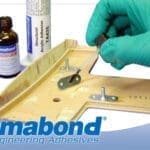Primers, Cleaners, Etchants, Initiators, Activators, Accelerators and Surface Conditioners are examples of chemicals used with adhesives. In some applications, they help to achieve desired results. The requirements of the process will guide the selection of the appropriate chemical. In some cases, the substrates must be primed. In other instances, the adhesive cure is triggered with an activator. Use products as recommended by the manufacturer for use with the adhesive in your application.
A primer is a surface coating that changes the character of a surface so that an adhesive or coating will adhere to it more effectively. The use of a primer can significantly increase the adhesive’s ability to wet out the surface.
Plastics often require a primer specific to certain types of plastics. For example, polyolefin primers increase adhesion to the surface of polyolefin. They can decrease adhesion when used on other materials, such as nylon and composites.
A particular adhesive type may also have a specific primer formulated for use. So while one primer will increase the adhesion of cyanoacrylate to the substrate, it will not increase the adhesion of a UV light curable adhesive.
Primers are not activators or accelerators. They will not cause cure or increase cure speed.
When accelerators are used to speed up the cure time, in most cases, there is a tradeoff in the bond strength. When bonding a very porous material with a cyanoacrylate, an accelerator applied to the substrate can increase adhesion by causing the cure before the material fully absorbs the adhesive.
Anaerobic adhesives cure only in the presence of metal ions. Some metals are more reactive than others. In those cases, a surface conditioner designed for anaerobic adhesives will increase the cure speed or allow cure on a non-metal surface. Like accelerators, anaerobic surface conditioners may cause a reduction in bond strength.

Standard industrial cleaners and solvents generally do the job. Knowing what the surface contaminants are makes cleaning them easier. Simple cleaning will do the trick to remove surface mold releases and plasticizers and allow the adhesive more direct contact with the plastic surface. For example, heavily plasticized PVC will have higher surface tension after wiping with isopropyl alcohol. Similarly, alcohol or acetone will remove many mold releases.
Some plastics respond well to a simple cleaning that eliminates the need for a primer without sacrificing the strength of the bond.
Etchants are acid-based solutions that prepare challenging surfaces for bonding. The surface energy of many metal compounds, and some plastics, such as fluoropolymers, will not be increased via either a cleaner or a primer. Some outsource the etching process.
In closing, not every adhesive application requires a chemical to achieve desired results. However, the use of one may be just the trick you didn’t know you were looking for! Consult the manufacturer for recommendations for your particular application.
If you need any further help or advice, please contact Permabond.